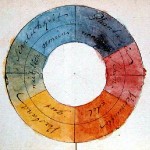 |
| Mandala created by the author, Carolyn Mehlomakulu |
Mandalas can be an excellent art therapy intervention for both children and adults. As The Mandala Project explains, the word “mandala” comes from the Sanskrit word for “circle.” However, it means more than just the shape and also encompasses the idea of wholeness and unity. Mandalas can be powerful symbols and have been present in many cultures and spiritual practices. Carl Jung is thought to have introduced the West to the idea of mandalas and often created mandalas as a form of self-expression and exploration of his internal world.
How to make a mandala:
To create a mandala, you simply start with a circle, and then fill in the circle with patterns, colors, and symbols. In my office, I keep pre-printed circle templates available, but at home you can easily trace something to get the size circle that you would like. You can work with any color paper and can use any drawing material that you like. Pencils work well for creating more structured or intricate patterns. Using paint is an option, but can be difficult for some when working within the structure of the circle. In art therapy, clients may be given an open-ended prompt to create the mandala by adding colors and patterns. Or they can be given a somewhat more specific prompt, such as to create a mandala to “show how you feel today.” At times, I have even used the mandala template as a container for anger, encouraging a frustrated child to “scribble all your anger inside the circle.” Mandalas can also be used as in intervention to explore the inner life versus the outer life: “Inside the circle, represent what is going on inside of you; outside the circle represent what is going in in your life around you.”
Purpose and benefits of mandala making:
Creating mandalas as art therapy can be a wonderful activity for centering, meditation, emotional expression, and self-soothing. Many people find the process of drawing and filling in the mandala to be very calming. In addition, the structure of the circle serves both to provide a sense of containment and to decrease anxiety. Seeing a blank, rectangular sheet of paper can for some people stir up anxiety around expectations that they make a “good” picture or cause them to feel that they do not know where to start. The circle gives you a starting place and reminds you that this is not a typical drawing. For myself, I also find that beginning with the circle helps me to approach my art-making with more introspection, mindfulness, and self-expression. Teaching clients about mandalas can provide them with a tool to use at home for relaxation and self-soothing. Some people may enjoy keeping a “mandala journal” in which they create a different mandala every day as a way to increase mindfulness and self-awareness. Both children and adults may enjoy filling in mandala coloring pages (Note: I do not use coloring pages in art therapy session, but have them available to send home as an enjoyable and calming activity).
To see more examples of mandalas, view the image gallery at The Mandala Project.
For mandala coloring pages, try these links or simply search in Google images:
– 233 Mandala Coloring Pages
– Mandalas from Coloring Castle
– Coloring Book Mandalas
Want more great art and writing prompts for exploring emotions, practicing mindfulness, developing healthy coping, increasing movement, and building healthy relationships? Be sure to check out my guided journal, The Balanced Mind.
Carolyn Mehlomakulu, LMFT-S, ATR-BC is an art therapist in Austin, Texas who works with children, teens, and families. For more information about individual therapy, child and teen counseling, family therapy, teen group therapy, and art therapy services, please visit: www.therapywithcarolyn.com.
This blog is not intended to diagnose or treat any mental health conditions. All directives, interventions, and ideas should be used by qualified individuals within the appropriate bounds of their education, training, and scope of practice. Information presented in this blog does not replace professional training in child and family therapy, art therapy, or play therapy. Art therapy requires a trained art therapist.
* Posts may include affiliate links (see full disclosure here). If you’d like to help support the blog without any extra cost to you, please click through on links and shop as you normally would. Your support is greatly appreciated!





Hi, this is the link for a post in my blog about mandalas. In Spanish
http://arteensalud.wordpress.com/2010/03/08/el-mandala-un-mapa-de-tu-conciencia/
Best
Gabriela
Hi Gabriela! Thanks for stopping by the blog. And thanks for sharing about your own blog and post about mandalas. It looks to be a great resource for art therapy information in Spanish.
Carolyn, thank you for the article. It is a wonderful process that I use in my own life and has a joyful meditative and clarifying effect. I invite you to have a look at http://www.facebook.com/lovingpsyche page where I too appreciate, post, and develop my own mandala drawings, and have recently published my own heart art mandala book.